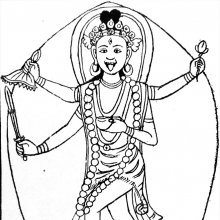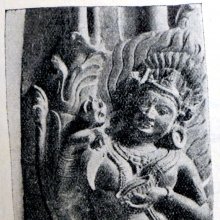Karota, Kārōṭa, Kāroṭa, Karoṭa: 12 definitions
Introduction:
Karota means something in Buddhism, Pali, Hinduism, Sanskrit, Marathi. If you want to know the exact meaning, history, etymology or English translation of this term then check out the descriptions on this page. Add your comment or reference to a book if you want to contribute to this summary article.
Images (photo gallery)
In Hinduism
Shaktism (Shakta philosophy)
Source: Shodhganga: Iconographical representations of Śiva (shaktism)Karoṭa (करोट) or Karoṭatantra refers to one of the twenty Bhūtatantras, belonging to the Śāktāgama (or Śāktatantra) division of the Āgama tradition. The Śāktāgamas represent the wisdom imparted by Devī to Īśvara and convey the idea that the worship of Śakti is the means to attain liberation. According to the Pratiṣṭhālakṣaṇasamuccaya of Vairocana, the Śāktatantras are divided into to four parts, the Karoṭa-tantra belonging to the Bhūta class.

Shakta (शाक्त, śākta) or Shaktism (śāktism) represents a tradition of Hinduism where the Goddess (Devi) is revered and worshipped. Shakta literature includes a range of scriptures, including various Agamas and Tantras, although its roots may be traced back to the Vedas.
In Buddhism
Tibetan Buddhism (Vajrayana or tantric Buddhism)
Source: OSU Press: Cakrasamvara SamadhiKaroṭa (करोट) refers to Karoṭaka—the “four skull bowls” of the Saṃvaramaṇḍala of Abhayākaragupta’s Niṣpannayogāvalī, p. 45 and n. 145; (Cf. Cakrasaṃvaratantra, Gray, David B., 2007).—The Cakrasaṃvara-maṇḍala has a total of sixty-two deities. [...] The Four skull cups in the cardinal directions, northeast, northwest, southwest, and southeast. Together with Cakrasaṃvara, Vajravārāhī, and the essence Yoginīs, they make up the jñāna-cakra, "the knowledge wheel".

Tibetan Buddhism includes schools such as Nyingma, Kadampa, Kagyu and Gelug. Their primary canon of literature is divided in two broad categories: The Kangyur, which consists of Buddha’s words, and the Tengyur, which includes commentaries from various sources. Esotericism and tantra techniques (vajrayāna) are collected indepently.
Languages of India and abroad
Marathi-English dictionary
Source: DDSA: The Molesworth Marathi and English Dictionarykārōṭa (कारोट).—m C Utter discomfiture or destruction; utter devastation or spoliation (as of an army, a field of corn, a village, a house).
Marathi is an Indo-European language having over 70 million native speakers people in (predominantly) Maharashtra India. Marathi, like many other Indo-Aryan languages, evolved from early forms of Prakrit, which itself is a subset of Sanskrit, one of the most ancient languages of the world.
Sanskrit dictionary
Source: DDSA: The practical Sanskrit-English dictionaryKaroṭa (करोट).—f.
1) The skull; Mv.5.19. वपुषि भटकरोटिन्यस्तकीलालसिन्धुः (vapuṣi bhaṭakaroṭinyastakīlālasindhuḥ) Dhan. V.
2) A cup or basin.
Derivable forms: karoṭam (करोटम्).
See also (synonyms): karoṭi.
Source: Cologne Digital Sanskrit Dictionaries: Edgerton Buddhist Hybrid Sanskrit DictionaryKaroṭa (करोट).—(m. or nt.; compare next; = Sanskrit and Pali karoṭi, cup, basin, also skull), lit. cup, basin (so in karoṭa-pāṇi, q.v.); in Lalitavistara (at least 305.22) fig. skull: Lalitavistara 258.6 (verse) na ca kumbhamukha-karoṭān (abl.) na dhārakuśalāntarāc ca gṛhṇanti; 305.22 (in description of monsters in Māra's host) kumbhodarāḥ karoṭapādā(ḥ) (Tibetan with feet resembling skulls, rkaṅ pa mgoḥi thod pa ltar ḥdug pa).
Source: Cologne Digital Sanskrit Dictionaries: Shabda-Sagara Sanskrit-English DictionaryKaroṭa (करोट).—mf. (-ṭaḥ-ṭiḥ or -ṭī) The bones of the head, the scull. E. ka the head, ruṭ to oppose, to defend, &c. affixes ac and in or ṅīṣ.
Source: Cologne Digital Sanskrit Dictionaries: Benfey Sanskrit-English DictionaryKaroṭa (करोट).—I. m. A basin; probably also cymbals in ṭakkarāghātasaṭāṃkārakaroṭikāḥ Rājat, 5, 417. Ii. m., and f. ṭā and ṭī, The skull, [Rājataraṅgiṇī] 6, 157.
Source: Cologne Digital Sanskrit Dictionaries: Monier-Williams Sanskrit-English Dictionary1) Karoṭa (करोट):—m. a basin, cup, [cf. Lexicographers, esp. such as amarasiṃha, halāyudha, hemacandra, etc.]
2) the bones of the head, the skull, [cf. Lexicographers, esp. such as amarasiṃha, halāyudha, hemacandra, etc.]
Source: Cologne Digital Sanskrit Dictionaries: Yates Sanskrit-English DictionaryKaroṭa (करोट):—[ka-roṭa] (ṭaḥ-ṭiḥ-ṭī) 1. m. 3. f. The bones of the head; the skull.
[Sanskrit to German]
Sanskrit, also spelled संस्कृतम् (saṃskṛtam), is an ancient language of India commonly seen as the grandmother of the Indo-European language family (even English!). Closely allied with Prakrit and Pali, Sanskrit is more exhaustive in both grammar and terms and has the most extensive collection of literature in the world, greatly surpassing its sister-languages Greek and Latin.
Kannada-English dictionary
Source: Alar: Kannada-English corpusKarōṭa (ಕರೋಟ):—[noun] the bony case of the brain of a vertebrate; the skull.
Kannada is a Dravidian language (as opposed to the Indo-European language family) mainly spoken in the southwestern region of India.
See also (Relevant definitions)
Starts with: Karota Honem, Karotaka, Karotam, Karotama, Karotan, Karotapani, Karotara, Karotatantra.
Ends with: Akarota.
Full-text: Karoti, Karotapani, Karotam, Karotika, Karotaka, Karota Honem, Karotatantra, Dharakushalantara, Samayakarotaka, Vajrakarotaka, Vishamaya, Samaya, Visamayakarotaka, Samayavisamayakarotaka, Samayavisamaya, Vinaka, Vajra, Ekajata.
Relevant text
Search found 3 books and stories containing Karota, Ka-rota, Ka-roṭa, Kārōṭa, Kāroṭa, Karoṭa, Karōṭa; (plurals include: Karotas, rotas, roṭas, Kārōṭas, Kāroṭas, Karoṭas, Karōṭas). You can also click to the full overview containing English textual excerpts. Below are direct links for the most relevant articles:
The Indian Buddhist Iconography (by Benoytosh Bhattachacharyya)
Dhammapada (Illustrated) (by Ven. Weagoda Sarada Maha Thero)
Verse 116 - The Story of Culla Ekasāṭaka < [Chapter 9 - Pāpa Vagga (Evil)]
A Correct Vision (by Venerable Professor Dhammavihari)

